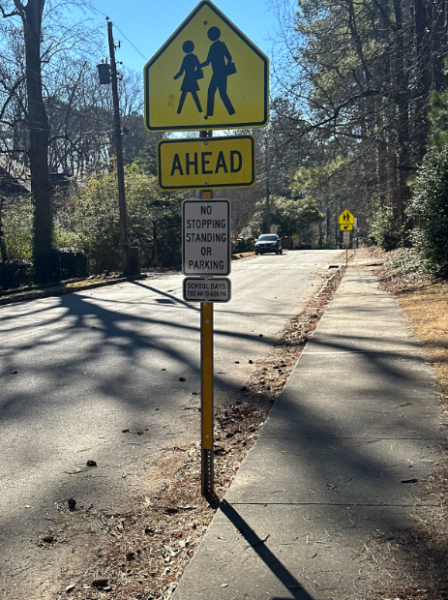Trouble With the Learning Curve: Students and Teachers Struggle to Adjust to Virtual Classrooms

School is back in session, and this year, COVID-19 has ensured that it is being attended mostly through online sessions. The transition to virtual learning has thrown a wrench into the normal workings of the school year and brought a host of new challenges. While students struggle to understand lessons delivered via Zoom, teachers at Chamblee have been presented with the challenge of adapting all of their lesson plans to suit distance learning, as well as navigating their way through a myriad of online platforms.
The most prominent platform in virtual learning this year is Google Classroom, as every class is required to have one.
“With Google Classroom, I find it far more user friendly and intuitive than TEAMS and OneNote,” said English teacher Adrienne Keathley. “So I like that both for myself and for the student. I like that Google Meet links are already placed. Really it’s just better for all stakeholders.”
The focus on Google Classroom marks a departure from last semester’s virtual learning, which was run through Verge.
“Verge is incredibly slow,” said Keathley. “It is slow to load things. It took me forever just to get from one assignment to the next. It would lag, just degrade. It’s clunky. It’s not well organized. You have to keep clicking around on stuff to find it. I hated Verge, so I was really happy when the county decided to support our efforts to move to Google Classroom.”
Teachers have not been completely without help in making the switch to online school, though some adaptation has been necessary.
“They’re trying to give us guidance,” said Carolyn Fraser. “You know, they’re trying to do the best they can at the various levels. It’s just the reality of it when you’re looking at 120 kids. It’s just different and it sounds good in the top down but the bottom up looks a little bit different. That’s all.”
At Chamblee, non-administrators have also been stepping up to the plate to assist in the transition.
“I personally think that the tech team that formed over the summer and put together a set of Google Slides with embedded links and how-to videos and step by step directions for those of us who needed it were incredibly helpful,” said Keathley. “Mr. Welser, Ms. Warren, Ms. Trepovich. There’s a couple others I’m not meaning to but I’m leaving off. That committee really did a nice job putting it together and being willing to answer our questions at all hours and in any form. I think that the Chamblee community really does come together and try to maintain the Chamblee standard of learning.”
Even with help, navigating the complexities of various websites and apps can prove complicated.
“I have to learn like, six or seven platforms at the same time,” said biology teacher Deann Peterson. “For someone who is not tech-oriented, I can’t even imagine what the teacher is going through. I’m tech-orientated and I’m still learning a lot. There’s different things that I’m doing and I have to learn it at the same time as I have to teach.”
Outside of technical difficulties, teachers must also adapt their teaching styles in order to teach without seeing students in person.
“I personally am struggling the most in the rapport department,” said Keathley. “Because I am really good at that face to face. I’m really good at building these tight knit communities where kids are willing to be vulnerable and take risks and talk candidly about really difficult topics sometimes and that is just really hard to accomplish through a screen.”
Because teachers can’t see their students in the classroom every day, communication has become very difficult as well.
“It is the communication with students,” said Fraser. “I’m having to communicate with them individually, whereas if we were in the building I could communicate with 35 of you all at once in one class. I have since Friday afternoon, when I started putting grades in, had over 200 emails and I have about nine I still need to reply to. It is just astronomical as far as multiplying time and effort with all these individual emails, because even if we say it in class kids don’t hear it and I understand they are still trying to understand how to use all that stuff, but it has just been overwhelming.”
The adoption of online classes may also force students to reevaluate how they learn.
“When you were in the building five days a week I literally handheld people through the curriculum,” said Fraser. “I can’t do that now, so this is where the disconnect is happening between students’ expectations and what teachers can actually be responsible for. I tried to preface that at the beginning of the school year, telling students and parents that the bulk of the responsibility of learning has now shifted from the teacher to the student, so we’re going to see how this works.”
As students are forced to adapt to the changing circumstances, many teachers are willing to be far more flexible than they would be in a typical school year.
“I myself am getting booted out of home meetings all the time,” said Keathley. “I had a TurnItIn debacle myself that erased my own data. I’m definitely being super lenient with the due dates as long as people communicate with me. If they can find a way to email me or text me, I will not take points off. I just want people to do work and to be proud of what they submit.”
Some anxiety about virtual learning has come from the experience of distance learning last semester.
“Last spring was just pathetic,” said Peterson. “It was just a crushed together mess that we tried to do and it didn’t work because the teachers knew that the students didn’t have to do the work and with the students knowing that they didn’t have to do the work nobody really tried very hard.”
So far, this semester has had significant differences from the sudden switch to virtual learning that ended the last school year.
“In my mind, it’s completely different,” said Keathley. “I mean last spring was a bandaid. I teach all seniors. Once they got out I was literally only getting five things from the five kids who still needed to pass to graduate. This time we’re able to hold people accountable and it’s completely different. It’s not just completion grades, we’re really trying to be innovative in the way we create virtual classrooms to mirror most closely what we strive for face to face.”
The added accountability has given some hope for a more productive semester.
“This year is so much better,” said Peterson. “We have to make it work. We have to make it engaging. We have to make sure that everybody is working. We have to keep it entertaining. It can’t be boring. So I think that for teachers, last spring, I could have cared less whether it was useful or not, but this year I want to excel at what I’m doing. I’m back to my old teaching method where I want to be an expert at this. It’s not happening yet, but we’ll work at it.”
Your donation will support the student journalists of Chamblee High School Blue & Gold. Your contribution will allow us to print editions of our work and cover our annual website hosting costs. Currently, we are working to fund a Halloween satire edition.

Vivien Orellana is a senior on the Blue & Gold. When she's not working, she is often napping, listening to music, or wasting time on the Internet. In five years, she hopes to have graduated college in minimal amounts of debt. This is her second year on the staff.




